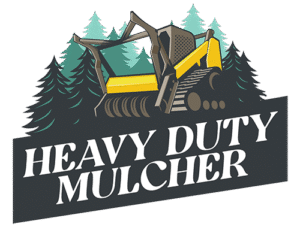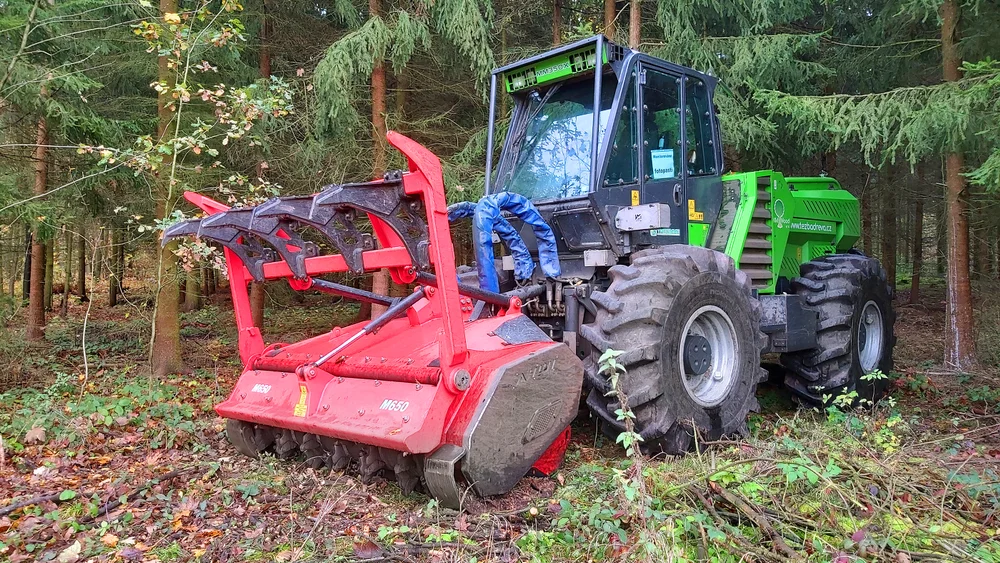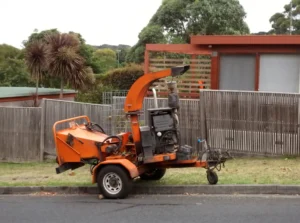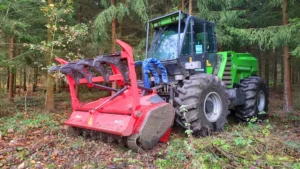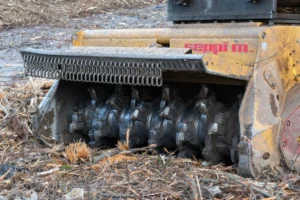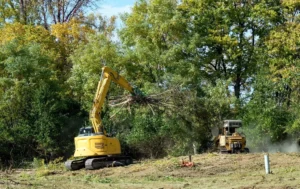Fuel is one of the most significant operating costs in mulching operations. On a heavy-duty head, even small changes in setup, maintenance, or operator habits can swing burn rate by gallons per hour. Over a season, that difference can amount to thousands in fuel costs and dozens of extra fuel deliveries. Mulcher fuel efficiency is not simply a matter of engine tuning. It is the result of how the drive, cutting head, cooling system, and the person in the seat all work together under sustained load.
This guide breaks fuel savings into a practical, field-proven sequence. Each step comes from work sites where crews maintained or improved productivity while using less fuel. By treating efficiency as part of the entire system, rather than a single adjustment, you can keep costs under control and avoid the common mistakes that waste both time and fuel.
Powertrain load management
Matching power output to cutting load is the foundation of fuel efficiency, because it dictates how much usable work you get for every gallon burned. In a mulching setup, the carrier engine, the hydraulic drive, and the cutting head all form one chain. If any link in that chain is mismatched to the others, you end up wasting fuel either by overloading or underloading the system.
An overloaded drive works harder than necessary, causing the engine to push into higher RPM ranges where fuel burn is steepest. This usually happens when bite size is too aggressive, teeth are dull, or the gear or pulley ratio forces the rotor to recover speed too slowly. Not only does this raise fuel consumption per cubic yard, it also produces more heat in the hydraulic system, which then demands more cooling power and further increases fuel use.
On the other hand, an underloaded head can be just as inefficient. When the bite is too small, or the feed rate is too conservative for the available power, the machine burns fuel to spin the rotor at speed without cutting much material. Over a long shift, that unused capacity is simply wasted energy.
The most efficient approach is to match the powertrain’s delivery to the load profile of the actual stand being cut. This involves setting relief pressures correctly, matching rotor speed to tooth type, and ensuring the drive protection system is tuned to absorb impacts without constant tripping. Use performance readings, such as pressure and rotor speed under load, to fine-tune the balance between speed and torque. Small adjustments here can cut fuel burn noticeably without lowering production, making powertrain load management one of the highest-return steps in improving mulcher fuel efficiency.
Drive type and efficiency losses
Every drive layout has its own fuel profile. Belt drives absorb shock well but can slip if tension is not maintained, turning energy into heat rather than cutting power. Direct drives minimize energy loss but require precise relief settings to avoid stalling under sudden load. Gearbox drives manage heavy torque well but introduce some efficiency loss through mechanical transfer.
The differences are covered in key differences in mulcher drive systems you can feel in the cut, where you will see how each type responds to impact and sustained feed. By understanding your layout’s strengths and weaknesses, you can adjust maintenance and operator technique to reduce wasted fuel.
Check your drive daily for tension, alignment, or oil level depending on the type. Heat in the belts, couplings, or gearboxes indicates energy is being lost. Reducing those losses directly lowers fuel consumption without sacrificing production speed.
Ratio and recovery speed
The gearing or pulley ratio between the drive and rotor has a direct effect on fuel use. A ratio that is too tall forces the rotor to recover speed slowly after impact, keeping the engine at high throttle for longer periods. A ratio that is too short may recover speed instantly but can push the relief system into dumping excess pressure, which wastes power.
Matching the ratio to the width of the head, the density of the stand, and the type of teeth is key. For example, wide heads cutting dense hardwood often benefit from slightly slower recovery to prevent relief dumping, while narrower heads in lighter stands can run faster to keep production high without penalty.
Impact of torque protection
Shear bolts, torque limiters, and relief valves protect the drive from overload, but they also affect efficiency. A fuse that trips too easily interrupts production and forces repeated restarts, each of which burns extra fuel without producing chips. One that is too rigid can allow damaging loads that cause expensive repairs.
Set torque protection according to actual field loads, not just the default settings. A well-calibrated protection system keeps fuel burn steady by avoiding both unnecessary trips and catastrophic failures.
Cutting setup for lower fuel burn

A cutting head that is balanced, sharp, and tuned to the actual stand conditions will always require less energy to move through the work. In heavy-duty mulching, every unnecessary pound of resistance at the rotor translates directly into higher fuel consumption. This resistance can come from dull or mismatched teeth, an unbalanced rotor, poorly adjusted doors, or simply a pattern that forces the head to re-cut material unnecessarily.
Sharp teeth cut with a slicing action that keeps hydraulic pressure in the optimal range, letting the engine work efficiently rather than forcing it into relief. When teeth are dull, chipped, or the wrong type for the job, the rotor needs more torque to achieve the same penetration, which increases fuel burn without improving production. Choosing the right tooth for the site, carbide for abrasive, dirty conditions and sharp steel for clean timber, reduces this load while maintaining cut quality.
Balance is equally important. A rotor with uneven tooth wear or mass distribution wastes power fighting vibration instead of cutting. This vibration also accelerates wear on bearings, seals, and mounts, creating a maintenance cycle that increases downtime and fuel use over the season. Replacing or rotating teeth in opposing pairs, and checking spacing during pre-operation inspections, ensures that energy is focused on the cut, not on shaking the head.
The final part of setup is discharge control. Doors and curtains that are too open increase chip throw distance, which takes more energy to overcome. Adjusting these for the site can lower resistance and help chips fall where you want them, rather than forcing the machine to fight backpressure or wasted throw. Together, these adjustments, sharpness, balance, and discharge control, form a setup that moves through material efficiently, keeps load steady, and directly reduces gallons burned per acre.
Tooth type and bite size
Tooth selection changes the amount of power needed per cut. Carbide teeth are durable in abrasive or rocky stands but often require more torque. Sharp steel teeth cut faster and with less energy in clean wood but dull quickly in mixed or dirty ground.
The wrong match wastes fuel. In abrasive sites, dull steel teeth force the operator to slow feed speed or take multiple passes, increasing total run time. In clean stands, carbide may last longer but consumes more energy per bite. Choose the right tooth for the conditions, and set bite size so it does not stall the rotor.
Smaller, consistent bites keep load steady. Large, uneven bites force pressure spikes that waste fuel. The strategic cutting patterns guide explains overlap, path choice, and approach angles that maintain production while lowering fuel burn.
Rotor balance and feed method
An unbalanced rotor shakes the head and wastes energy. Replace or rotate teeth in opposing pairs and confirm even wear. When feeding, keep motion smooth. Avoid swinging into the cut or forcing deep bites that cause stalling. A smooth feed keeps the engine in its most efficient load range.
Poor balance also stresses bearings and seals, leading to heat buildup that forces fans to run harder. This is fuel that could be spent cutting instead of cooling.
Discharge control and door settings
Controlling chip throw saves energy. Doors and curtains that are fully open throw chips farther, which increases resistance and fuel use. In most jobs, you can shorten throw distance without affecting chip management.
Set deflectors and doors for the terrain, adjusting as you move between open areas and tight buffer zones. This not only improves efficiency but also extends curtain life and reduces the chance of damage from stray debris.
Cooling system and fuel economy
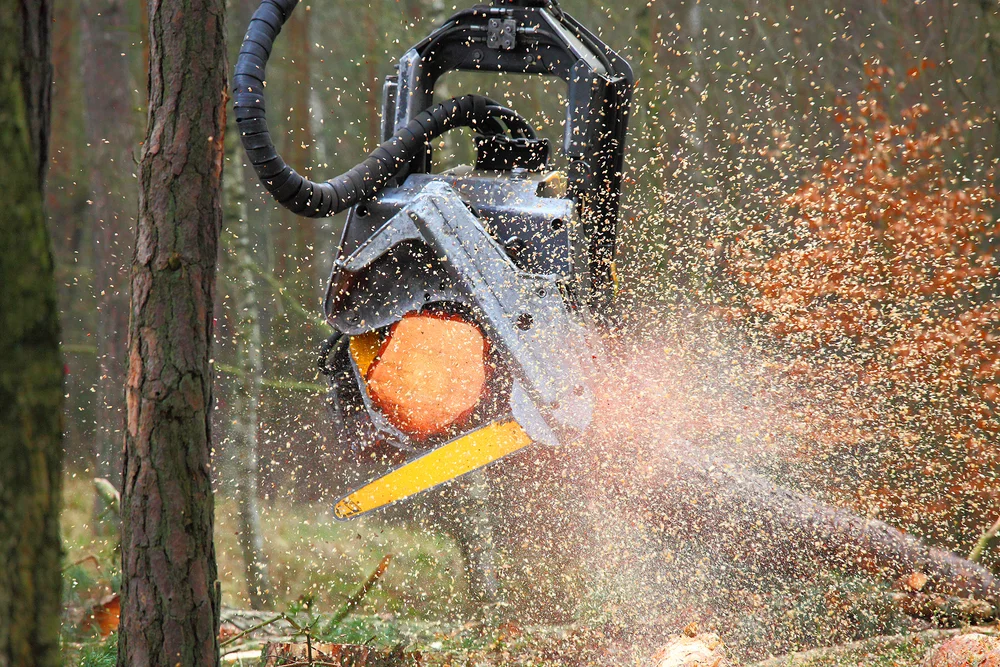
Heat management is directly tied to fuel use, because a hot-running machine forces the cooling system to work harder, and that extra cooling load comes straight from the engine. If the cooling system is clogged, restricted, or poorly maintained, the fans will run longer and at higher speeds, pulling additional horsepower from the powertrain. Every extra horsepower the fan consumes is fuel that never reaches the rotor.
A clean, efficient cooling system minimizes this parasitic load. Fine debris from mulching, especially fibers, dust, and seed fluff, clogs screens and cores quickly, forcing fans to work at maximum duty just to keep temperatures within range. This not only burns more fuel, it can also create a cycle where higher operating temperatures thin the oil, reduce hydraulic efficiency, and trigger even more cooling demand. Over time, this compounds into a measurable increase in gallons burned per hour.
Airflow and debris control
Cooling packs need clear airflow to work efficiently. Fine debris builds up quickly, especially in high-fiber stands. Screens must be clean and sealed so dust does not bypass the core. Airflow restrictions cause the system to run hotter, which triggers the fans to consume more power.
The cleanout patterns in how mulchers perform in rocky or uneven terrain are just as important here, even if the site looks clean.
Fan control and timing
Reversible fans are most efficient when used early. Waiting until the temperature gauge climbs forces a full-speed cleanout, which burns more fuel. Run short reversals regularly to keep airflow consistent.
If your carrier allows fan speed adjustments, set thresholds to match seasonal and site conditions. Lower thresholds in hot, dusty weather prevent heat spikes that are harder to manage.
Oil cleanliness and heat load
Dirty oil increases hydraulic resistance, forcing pumps to work harder. Follow the practices in long term care of industrial mulchers to keep oil clean and temperature stable. This reduces parasitic losses and keeps fuel burn predictable.
“Fuel efficiency comes from dozens of small habits. Miss one, and you barely notice. Miss several, and you are hauling fuel twice as often.”
— Kyle Brennan, Senior Field Technician
Operator habits that save fuel
Even the most efficient mulcher setup will waste fuel if the operator’s habits are inconsistent or poorly matched to site conditions. Operator input directly controls engine load, hydraulic efficiency, and cutting performance. A skilled operator can stretch each gallon further simply by managing feed rate, timing, and idle control. Over the course of a long shift, these small adjustments can translate into significant fuel savings without reducing production output.
Smooth feed and watch points
A steady, predictable feed rate keeps the engine operating within its most efficient load range. When an operator pushes too hard into dense material, the system reaches relief pressure, dumping hydraulic energy as heat rather than using it to cut. This not only wastes fuel but also increases wear on pumps, hoses, and teeth. On the other end of the spectrum, creeping too slowly undercuts efficiency by letting available horsepower go unused.
The goal is to find the “fuel sweet spot” where chip flow, rotor speed, and engine load remain steady. Feathering the control to adjust bite size before the head bogs down prevents overload cycles. Watch chip discharge closely, as a smooth, consistent stream is a good indicator of efficient cutting. Monitoring in-cab gauges for RPM, pressure, and temperature can help operators adjust in real time, staying within the optimal efficiency band.
Idle control and shutdown timing
Extended idling is one of the most common and easily avoidable sources of fuel waste. A mulcher burns fuel even when the head is not cutting, and over the course of a day, idle time can add up to gallons lost. If the head will sit idle for more than a couple of minutes—during staging, planning, or short delays—idling down or shutting off the head drive reduces fuel burn instantly.
On large blocks with frequent moves between cutting zones, shutting down the carrier entirely during relocations can save even more fuel. Modern machines restart quickly, and the few seconds it takes to power back up are easily offset by the fuel saved. Building these shutdown habits into daily workflow ensures operators cut only when needed, reducing both fuel consumption and unnecessary wear on the machine.
Use of automation and diagnostics
Load control systems adjust engine speed to match demand. Use them when available. Monitor diagnostics to see when you are approaching relief and adjust feed rate before the system wastes fuel. The pre operation inspection process ensures sensors are accurate so the operator can trust the readings.
Get a fuel efficiency action plan
Fuel savings come from coordinated effort across machine setup, maintenance, and operation. A one page fuel efficiency sheet in the cab keeps the crew aligned on best practices.
Your plan should include ratio and bite size rules, door and curtain settings, cooling and oil care steps, and idle guidelines matched to your carrier and head. You can contact us for a ready-to-use plan tailored to your machines, stand types, and seasonal conditions. It is a simple way to keep burn rate low and output high from job to job.
